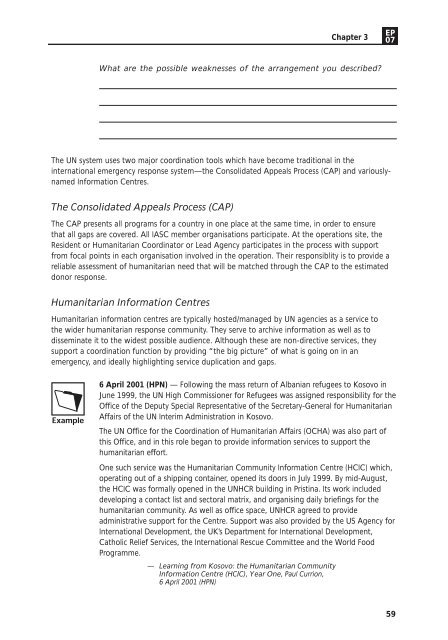Coordination - Disaster Management Center - University of ...
Coordination - Disaster Management Center - University of ...
Coordination - Disaster Management Center - University of ...
Create successful ePaper yourself
Turn your PDF publications into a flip-book with our unique Google optimized e-Paper software.
Chapter 3EP07What are the possible weaknesses <strong>of</strong> the arrangement you described?The UN system uses two major coordination tools which have become traditional in theinternational emergency response system—the Consolidated Appeals Process (CAP) and variouslynamedInformation Centres.The Consolidated Appeals Process (CAP)The CAP presents all programs for a country in one place at the same time, in order to ensurethat all gaps are covered. All IASC member organisations participate. At the operations site, theResident or Humanitarian Coordinator or Lead Agency participates in the process with supportfrom focal points in each organisation involved in the operation. Their responsiblity is to provide areliable assessment <strong>of</strong> humanitarian need that will be matched through the CAP to the estimateddonor response.Humanitarian Information CentresHumanitarian information centres are typically hosted/managed by UN agencies as a service tothe wider humanitarian response community. They serve to archive information as well as todisseminate it to the widest possible audience. Although these are non-directive services, theysupport a coordination function by providing “the big picture” <strong>of</strong> what is going on in anemergency, and ideally highlighting service duplication and gaps.6 April 2001 (HPN) — Following the mass return <strong>of</strong> Albanian refugees to Kosovo inJune 1999, the UN High Commissioner for Refugees was assigned responsibility for theOffice <strong>of</strong> the Deputy Special Representative <strong>of</strong> the Secretary-General for HumanitarianAffairs <strong>of</strong> the UN Interim Administration in Kosovo.The UN Office for the <strong>Coordination</strong> <strong>of</strong> Humanitarian Affairs (OCHA) was also part <strong>of</strong>this Office, and in this role began to provide information services to support thehumanitarian effort.One such service was the Humanitarian Community Information Centre (HCIC) which,operating out <strong>of</strong> a shipping container, opened its doors in July 1999. By mid-August,the HCIC was formally opened in the UNHCR building in Pristina. Its work includeddeveloping a contact list and sectoral matrix, and organising daily briefings for thehumanitarian community. As well as <strong>of</strong>fice space, UNHCR agreed to provideadministrative support for the Centre. Support was also provided by the US Agency forInternational Development, the UK’s Department for International Development,Catholic Relief Services, the International Rescue Committee and the World FoodProgramme.— Learning from Kosovo: the Humanitarian CommunityInformation Centre (HCIC), Year One, Paul Currion,6 April 2001 (HPN)59








